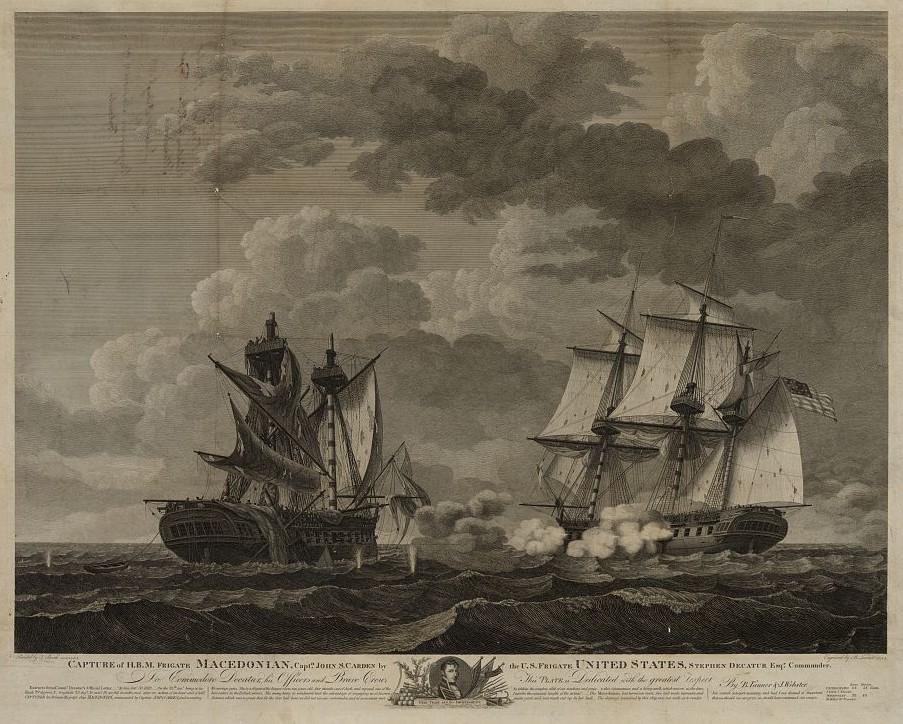Originally written by Carl White.
Seeds For War of 1812
The War for Independence – known as the American Revolutionary War – was fought from 1775 to 1783. It ended with the Treaty of Paris, but some historians considered the treaty weak. The Treaty did not guarantee the survival of the new country, nor did it guarantee our right to trade. It wouldn’t be too long before we were again challenged by the British during the War of 1812. With an eye to the future, the young country started to build its military while pursuing diplomacy.
President Madison reported to Congress in 1806 on British interference. In June 1807, the British ship Leonard fired on the American ship Chesapeake. Although the Americans imposed an embargo on the British, it backfired and had a disastrous effect on our economy. It was discontinued. Meanwhile, Britain and France became involved in a prolonged war, which directly affected us. The British in Canada encouraged Indian raids on American settlements along the western border. The French conducted attacks on American shipping from 1798 to 1801. In 1803, Great Britain forbade the US to trade with France. From 1803 to 1811, the British began to impress American sailors into service on their ships in preparation for war. This was viewed by the Patriots as an attempt to reimpose British authority over the country.
United States Enters War of 1812
After years of interference, the United States finally declared war on Britain in June 1812. Between June and August of 1812, there were riots in Baltimore over conscription. In July 1812, the first of three attempts were made to invade Canada – the home base for the British. American forces were turned back. US troops captured and burned Toronto, while Captain Perry defeated the British at the Battle of Lake Erie in 1813. From August 24th to 25th, British forces burned Washington DC. It was during the Battle of Baltimore that Francis Scott Key penned the Star Spangled Banner. Each side experienced success and failure until the United States got the upper hand. Both sides agreed to the terms of the Treaty of Ghent, which was ratified in February 1815. This went a long way in establishing an American identity and fostering a new respect for our country throughout the world.
Greenwich Takes Action
The War of 1812 had a limited effect on Greenwich. There was little concern, and there were no public meetings held, or major actions taken. England claimed that every person born within her dominions owed service to Britain, regardless of the time period. This was their justification for impressing sailors. It did not sit well with the newly independent country. When the call was issued for volunteers, as in all wars, Greenwich responded. Most of the war was fought on water, and Long Island Sound was an important waterway for ships headed to New York. It’s no surprise the British secured the eastern end and attempted to move west passed Greenwich. Britain controlled the Sound in 1813 and burned and sunk many vessels. As a result, like other communities along the southern coast, Greenwich established a military presence to guard against British attacks. By September 1813, the British had pushed their way almost to Throgg’s Neck.

British Invasion Rumor
In response, Colonel Samuel Dean of Stamford called out the 9th Regiment of the Connecticut Militia to guard the coast. Several companies were affected: Captain Seth Mead’s Company (Horseneck), Captain Horton Reynold’s Company (Horseneck), Captain Alexander Hendrie’s Company (Old Town), and men from the Regular Army (25th, 29th and 37th Infantry). While some companies were located on Field Point, others were located at Mead’s Point and Greenwich Point. Major Ebenezer Mead, Jr. of the 9th Connecticut Regiment was credited with preventing the British from landing along the coast and forcing their withdrawal from Long Island Sound.
Although several companies were dismissed when the British retreated, an elaborate alarm system was developed in the event the British were to return. Church bells were to be rung to call out the Connecticut regiments. As chance would have it, one morning there was a fierce ringing of the bells. Rumor had it that the British had landed at Greenwich Point. The militia met at the meeting house in Old Greenwich, approximately 2 miles from Greenwich Point. A sole volunteer, Whitman Mead, agreed to surveil the Point. Once he arrived, he realized that the ships were American gunboats directed by Commodore Lewis. They were searching for a British privateer and came ashore for breakfast. Mead tarried for breakfast, not knowing his comrades worried that he had been kidnapped. He eventually returned to allay their fears.
We owe a great deal of gratitude to all those who have served our country. As we celebrate July 4th, we will be reminded that many people have fought and died to protect our independence and way of life. We should be very proud of them.
SOURCE
Mead, S: Ye Historie of Ye Towne of Greenwich; Knickerbocher Press, NYC, 1911, 1979
ABOUT
Build your family tree, dive into the history of your historic home, and discover photos and articles of days gone past with the Library’s collection of 5,000 books, 800 Oral History transcripts, yearbooks, historical maps, vertical files, pamphlets, periodicals, and microfilm and microfiche. Plus, access resources like American Ancestors, AncestryLibrary, and more with a Library card. Learn more at greenwichlibrary.org/genealogy.
Get the latest about the Library’s History & Genealogy events and offerings sent to your email: greenwichlibrary.org/enews.
Questions? Contact:
Local History Librarian
(203) 622-7948
